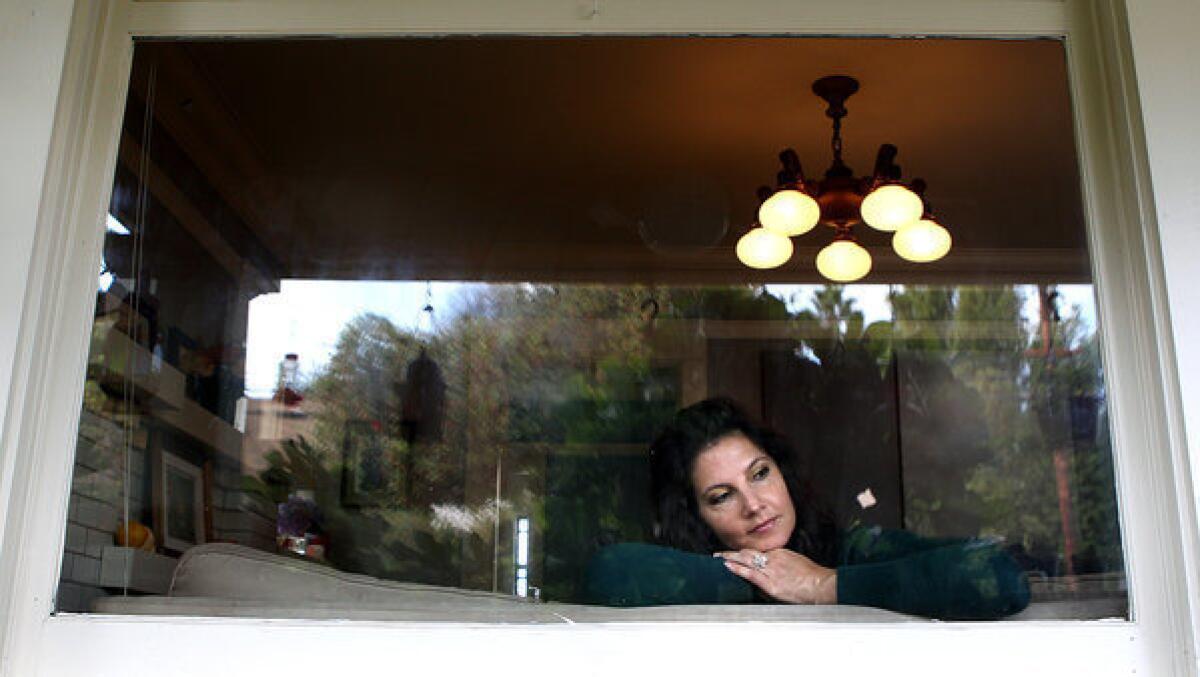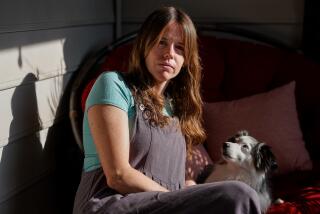Reality shows may put crews too close to cutting edge

Monica Martino had filmed tornadoes in the Midwest, ship collisions in the Antarctic and crab fishermen in Alaskaâs Bering Sea. But those experiences didnât prepare her for a terrifying nighttime boat ride in the Amazon jungle.
In February, the 41-year-old co-executive producer was thrown into a murky river after getting footage for âBamazon,â a series for the History cable channel about out-of-work Alabama construction workers mining for gold in the rain forest of Guyana.
Martino says the captain was blind in one eye and piloting too fast without a proper light. He lost control of the boat while making a hard turn, sending the crew into the river, where Martino was knocked out by the impact of hitting the water at high speed.
Pulled back into the boat, Martino regained consciousness. But on the journey back to base camp, the vessel struck a tree, slamming Martino into the deck. Although she sustained a concussion, bruised ribs and a badly torn shoulder, Martino said, she had to wait 19 hours to receive medical care at a clinic in Venezuela because the production company had no viable medical evacuation plan for the crew.
History and the production company, Red Line Films, declined to comment.
âIt was a whole cascade of negligence,â said Martino, who lives in Santa Monica. âWe were put in a situation far beyond what any production crew should be expected to handle.â
As reality TV has boomed over the last decade, action-adventure shows have become a lucrative niche in a medium hungry for high ratings. But the growth has also stirred concerns that some reality TV programs are cutting corners on safety, exposing cast and crew members to hazardous conditions.
A combination of tight budgets, lack of trained safety personnel and pressure to capture dramatic footage has caused serious and in some cases fatal incidents, according to interviews with television producers, safety consultants and labor advocates.
Even the companies that provide insurance to Hollywood films and TV shows are reluctant to write policies for some of the edgier programs.
âThese reality shows are getting riskier to get more ratings,â said Wendy Diaz, senior underwriting director for the entertainment division of Firemanâs Fund Insurance, one of the leading insurance carriers that serve the entertainment industry.
Records from OSHA and the state Division of Occupational Safety and Health show fewer than a dozen citations and accidents involving reality TV sets in the last five years, including a fatality that occurred this summer in Colorado during production of a proposed Discovery Channel series. But union officials, safety consultants and producers say those numbers donât begin to reveal the true extent of the problem.
PHOTOS: Where the last seasons left off
Many incidents go unreported because crew members sign non-disclosure agreements and fear being blacklisted if they file lawsuits. Record-keeping is further muddled by the fact that many of the shows are nonunion, and workers are often classified as independent contractors. OSHA typically tracks only serious accidents involving employees and has no jurisdiction if the incident occurs in a foreign country such as Guyana.
âReality has a lot of near-misses and things that happen that you never hear about,â said Vanessa Holtgrewe, an industry veteran and former camera operator on âThe Biggest Loserâ and âThe X Factorâ who now works as an organizer for the International Alliance of Theatrical Stage Employees. âOn a lot of these shows, youâre completely on your own. There is no one you can call if ⌠you feel youâre in a dangerous situation.â
State and federal OSHA officials declined to comment specifically on incidents involving the reality TV sector.
Firemanâs Fund estimated that it would underwrite 160 action-adventure reality shows in 2012, a 25% increase over the previous year. But it passed on about 50 other reality TV programs because they were deemed too risky, Diaz said.
âWe had people who wanted to go to Mexico to follow the drug cartels around,â Diaz said. âWe had one show where they were going to blow up a mine. We told them we wouldnât insure the show.â
Reality series â which cover everything from âSurvivorâ to âKeeping Up With the Kardashiansâ â have provided a huge revenue stream for cable and broadcast networks. The shows have lower production costs than scripted entertainment and tend to attract the younger viewers favored by advertisers.
CRITICâS NOTEBOOK: Try to believe in the new TV season
Among the most popular are action-adventure shows such as the dramatic fishing series âDeadliest Catchâ and the Arctic driving drama âIce Road Truckers,â which give viewers an inside glimpse into gritty, hazardous real-life occupations. The number of shows on the air in this category rose from fewer than a dozen five years ago to nearly 60 in 2012, according to Bob Boden, a veteran executive producer and industry analyst.
The element of danger is vital to the marketing campaigns. Historyâs âOutback Hunters,â for example, touts the âdangerous work conditionsâ of hunters who risk âlife and limb to hunt crocodiles in the Australian outback.â A press release for the cable channelâs âAx Menâ promises âmishaps involving falling trees, bone-crushing equipment, razor-sharp cables and human error.â
âA lot of these reality shows are ⌠encouraging people to do dangerous acts,â said state Sen. Ted Lieu (D-Torrance), who heads the Senateâs Labor and Industrial Relations Committee. âIf you do that without adequate safety standards, people will get hurt.â
Lieu said his staff is investigating possible safety infractions by reality TV shows.
Cast and crew members who work on action-adventure shows are vulnerable for several reasons. Unlike movies and scripted TV programs, reality shows typically rely on members of the public to perform stunts, and often lack designated safety experts with the proper training to prevent accidents. Camera operators are trained to shoot in a cinema verite style, close to the action, often in dangerous locations. And shows operate under tight budgets and schedules that can force crews to work too quickly and make decisions on the fly.
âIn a lot of production scenarios, they are not employing people with the right skill sets or doing their due diligence,â said Lars Andrews, a Vancouver, Canada, safety consultant and producer who has worked on such shows as âEco Challenge,â âSurvivorâ and âThe Amazing Race.â He said the problem is more prevalent on low-budget cable shows, not network shows such as âSurvivor.â
Producers also sometimes push the limits of safety to capture the most realistic and dramatic footage. âYouâre put in situations where decisions are made under pressure,â Andrews said. âThe ball gets rolling. One bad decision leads to another.â
Andrews remains haunted by a 2010 incident in which a colleague on a reality program filming in a Venezuelan jungle died of snake bite. Although a paramedic was on the set and the crew had snake venom antidote, the man went into shock and could not be evacuated because it was too late in the day to fly in a helicopter.
âWe wanted to get some snake footage. It was the last shot of the day,â he said. âMaybe it was not the appropriate timeâ to shoot the scene, Andrews said.
To be sure, fatal accidents also happen on the sets of scripted films and TV shows. A stuntman was killed in 2011 by an explosion on the set of âThe Expendables 2â in Bulgaria. A crew member on the sci-fi series âThe X Filesâ was electrocuted in 2000.
But such incidents have declined sharply since 1982, when star Vic Morrow and two child actors were killed by a helicopter that crashed into them during filming of âTwilight Zone: The Movie.â The deaths led to scrutiny of safety standards and prompted tougher rules for film crews.
Labor advocates argue that safety would be improved by unionizing shows, providing health insurance benefits and implementing stricter workplace safety rules, such as limiting âturnaround timeâ so crews get enough rest between shoots that can last up to 20 hours a day.
âIt all stems from the race to cut budgets to the bone,â said Lowell Peterson, executive director of the Writers Guild of America, East. âWe understand the desire of networks to buy programming at as low a price as possible ... but you have people getting hurt in the field. You need to have safety protections and rational production schedules.â
A strong opponent of the union push in action-adventure shows is widely recognized pioneer Thom Beers. A Harley-riding thrill seeker who got his start as an assistant at Turner Broadcasting and went on to produce the hit shows âDeadliest Catch,â âIce Road Truckersâ and âMonster Garage,â Beers recently bragged that he had just been in Alaska âdrinking Jack Daniels straight from the bottleâ with his âDeadliest Catchâ fishermen.
While the burly, bearded producer didnât deny that his crews face danger on the job, he insisted that they are aware of the risks â and well compensated. Camera operators typically earn $700 to $1,000 a day on action shows.
âWe realize the fact that they are putting their lives in danger, which is why we take care of them,â Beers said. âWe pay them very, very well, way beyond scale, for what they do.â
Although Beers declined to discuss the effort to unionize reality shows, many of his peers say that they couldnât afford to produce their shows if they had to pay health and pension benefits and comply with union work rules.
Doug Stanley, a cinematographer who has won Emmys for his work on âDeadliest Catchâ and now runs his own production company, has broken his ribs, gashed his hand and permanently damaged his right knee.
When getting ready to shoot the first season of the show in 2005, Stanley, now 50, tripped and smashed his face into a crab pot. The next morning, with his jaw broken in three places, he boarded the boat for weeks of work in some of the worldâs roughest seas.
Stanley sees nothing wrong with asking TV workers to perform dangerous tasks as long as they are informed of the hazards involved. Besides, the company behind the show wrote him a check for about $13,000 to cover the injuries from his crab-pot accident.
And forget trying to apply union safety regulations to shows like âDeadliest Catch.â
âThereâs no way it could be made under union rules,â Stanley said.
For a pilot for a proposed Discovery Channel series tentatively titled âBrothers in Arms,â Terry Flanell and her husband, Melvin Bernstein, were being filmed at their Colorado shooting range in June 2012 when two smoke bombs detonated and sent metal pipes through the air. One struck and killed Flanell.
âIt took off like a rocket [and] went through her,â Bernstein said. âIt was terrible.â
Bernstein said he had already complained that there was no pyrotechnics expert on set, after his brother and his brotherâs girlfriend were injured in an explosion the day before.
âThey were taking too many short cuts to save money,â Bernstein said.
Officials with the Bureau of Alcohol, Tobacco, Firearms and Explosives said they were investigating the incident. OSHA, after investigating, did not issue a citation, saying it could not be determined that Flanell was an employee of the company that operates the shooting range. A representative for Discovery and the showâs producers declined to comment.
Martino, still recovering from her injuries, returned to her producer job on âBamazonâ after the accident, but said she was fired in May after a physician said she needed surgery on her shoulder. She is preparing to sue Red Line for wrongful termination and negligence, alleging that it ignored safety rules and relied on a fabricated medical evacuation plan for the crew.
âYou get banged up when you work on these shows because itâs a physical job, but Iâve never had anything like this happen to me,â Martino said. âTo have two accidents in the same night â we put ourselves in such extraordinarily dangerous circumstances.â
MORE
INTERACTIVE: TVs highest paid stars
INTERACTIVE: YouTubeâs viral videos of 2012
PHOTOS: Hollywood back lot moments
More to Read
Sign up for Essential California
The most important California stories and recommendations in your inbox every morning.
You may occasionally receive promotional content from the Los Angeles Times.












